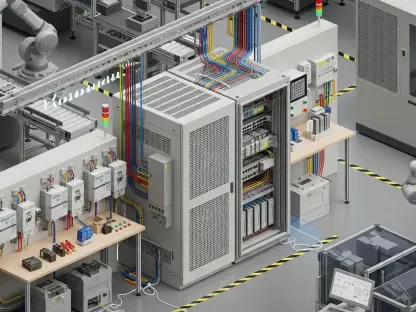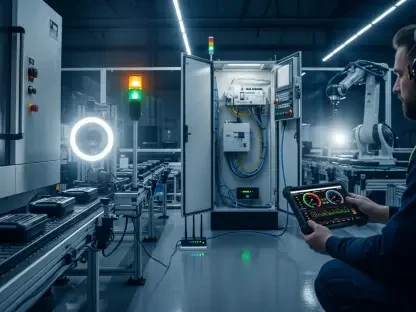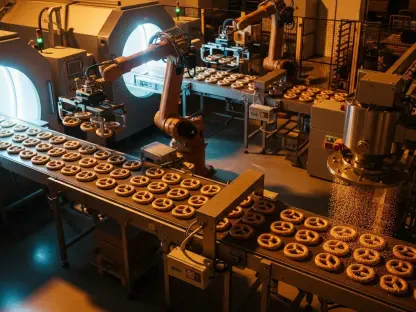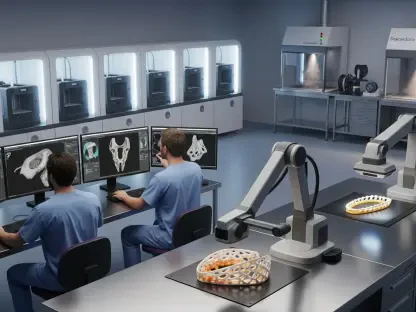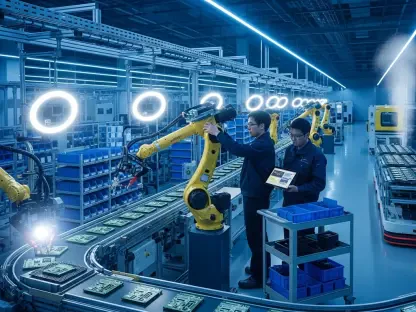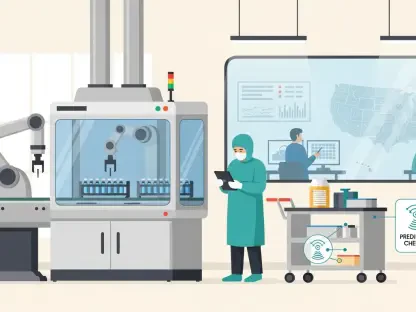In an era where technology often feels intangible, Bambu Lab has taken a bold leap by opening its first-ever flagship retail store in Shenzhen, China, creating a tangible bridge between the intricate world of 3D printing and everyday consumers who are eager to explore this innovative field. Nestled in the vibrant Nanshan District, this 244-square-meter space is more than just a shop; it’s an immersive experience designed to captivate and educate. Visitors are greeted with interactive displays and hands-on opportunities, showcasing how additive manufacturing (AM) can fit into daily life. This move by Bambu Lab, a prominent name in desktop 3D printing, signals a transformative shift in how the industry engages with its audience, prioritizing direct interaction over distant digital interfaces.
The store itself is a visual feast, featuring a striking wall of A1 printers that immediately draws attention upon entry. Alongside this, a colorful array of filament spools is available for purchase, catering to creators eager to experiment with bold designs. Beyond mere retail, this space serves as a hub for inspiration, fostering a deeper connection with the 3D printing community. It’s a deliberate effort to break down the barriers that often make cutting-edge technology seem inaccessible, inviting hobbyists and curious newcomers alike to explore the possibilities of AM in a welcoming environment.
A standout feature within the store is a gallery displaying intricate 3D-printed models crafted by top talents from the MakerWorld platform. This showcase not only highlights the potential of Bambu Lab’s technology but also builds a bridge between creators and consumers through a mini-market where these designs can be bought. Such initiatives reflect a commitment to community-driven innovation, turning abstract concepts into tangible products that visitors can appreciate and take home. It’s a subtle yet powerful way to demonstrate the real-world impact of 3D printing.
Adding to the allure, the CyberBrick diorama stands as a testament to the scale of AM capabilities, constructed using over 100 ##D printers running non-stop for a week. This massive, interactive display invites visitors to engage directly with the technology, offering a memorable glimpse into what 3D printing can achieve when pushed to its limits. This attraction underscores Bambu Lab’s mission to not just sell products but to inspire awe and curiosity, making the technology feel both approachable and extraordinary at the same time.
Industry Trends in 3D Printing Accessibility
Bridging the Gap with Consumer Spaces
Bambu Lab’s new store in Shenzhen exemplifies a rising trend within the AM industry to make the technology more accessible by creating physical spaces for direct engagement. This retail venture is not merely about sales but about education and inspiration, allowing individuals to interact with 3D printers and witness their potential firsthand. Located in a bustling tech hub, the store offers a unique opportunity for hobbyists, students, and casual visitors to explore a full range of printers and materials in a real-world setting. By doing so, it helps demystify a field often perceived as complex or reserved for industrial use, paving the way for broader adoption among everyday users who might have previously felt excluded from such advancements.
This consumer-centric approach also serves as a platform for feedback and innovation, as visitors can share their experiences and ideas directly with the brand. The presence of community-driven elements, such as galleries of user-created designs, fosters a sense of belonging and collaboration that transcends traditional retail. Bambu Lab’s initiative in Shenzhen is a clear indicator of how AM companies are rethinking their role, moving beyond manufacturing to become educators and community builders. This shift could redefine how technology is introduced to the masses, making 3D printing a household concept rather than a niche interest.
Global Efforts in Demonstration Hubs
Parallel to Bambu Lab’s retail experiment, other players in the AM sector are enhancing accessibility through dedicated demonstration hubs and reference sites. For instance, Meltio, a company specializing in wire laser metal deposition technology, has established a significant facility in the U.S. to showcase its capabilities to both industrial clients and international partners. These hubs allow for live demonstrations of advanced systems, highlighting practical applications like on-demand repairs and lightweight manufacturing. Such efforts are crucial in industries like defense and security, where seeing the technology in action can build trust and drive adoption.
These demonstration sites complement retail initiatives by targeting a different audience—professional and industrial users who require tailored solutions. By offering a space to test and observe AM processes, companies are addressing the skepticism that often accompanies new technology, providing concrete evidence of its value. This trend of localized hubs, alongside consumer-focused stores, illustrates a comprehensive strategy within the industry to reach diverse demographics. It’s a dual approach that ensures AM is not only understood by enthusiasts but also embraced by sectors with specific, high-stakes needs, amplifying its overall impact.
Technological and Application-Specific Innovations
Cutting-Edge Research in Adaptive Materials
On the frontier of AM research, groundbreaking developments in AI-driven 3D printing are redefining the possibilities of shape-morphing materials. Researchers at Northwestern University have pioneered a framework that uses artificial intelligence to design and print materials capable of adapting their shapes in response to environmental stimuli like heat or light. This innovation, which leverages liquid crystal elastomers, enables rapid creation of responsive designs for applications in robotics and medical devices. The ability to autonomously determine optimal material distribution and printing parameters marks a significant leap forward, reducing design time to mere minutes and adapting swiftly to evolving needs.
This advancement is poised to transform industries requiring dynamic solutions, such as creating medical implants that adjust to bodily changes or robotic components that shift form for different tasks. Unlike traditional manufacturing, which often struggles with such flexibility, this AI-integrated approach offers a glimpse into a future where materials are as intelligent as the systems they support. It’s a compelling example of how AM is evolving beyond static production into a realm of adaptive, smart technology, opening doors to applications previously thought unattainable and enhancing the relevance of 3D printing in cutting-edge fields.
Tailored Solutions for Aerospace and Maritime Sectors
Equally impressive are the strides being made in sector-specific AM applications, particularly in aerospace and maritime industries. Boeing has introduced a revolutionary 3D-printed solar array substrate method that slashes production times for satellite components by up to six months, a 50% improvement over traditional processes. By integrating features directly into panels, this approach eliminates numerous parts and steps, streamlining manufacturing for both small satellites and larger spacecraft. Such efficiency not only reduces costs but also accelerates deployment schedules, a critical factor in the fast-paced aerospace sector.
Meanwhile, the maritime field is witnessing innovation through projects like the Digitally Enabled Efficient Propeller (D.E.E.P.) initiative, which explores AM for next-generation marine propellers. This collaborative effort, involving multiple research and industry partners, aims to create smart, self-monitoring hardware using digital twin technology. The potential to produce customized, high-performance components on demand could redefine maritime engineering, addressing challenges like durability and efficiency in harsh ocean environments. Together, these developments highlight AM’s versatility, proving its capacity to solve unique, industry-specific problems while pushing the boundaries of what manufacturing can achieve.
Expanding Horizons with Integrated Technologies
Another dimension of AM innovation lies in the integration of complementary technologies like digital twins and advanced materials, which are amplifying the technology’s impact across various domains. Digital twins, virtual replicas of physical objects, are being paired with 3D printing to enhance design precision and performance monitoring, as seen in maritime projects aiming for smarter hardware. This synergy allows for real-time adjustments and predictive maintenance, ensuring that printed components meet stringent operational demands with minimal downtime or error.
Additionally, the exploration of novel materials is expanding the scope of what AM can accomplish, from lightweight aerospace parts to responsive medical tools. These materials, often developed through rigorous research, enable properties like flexibility or thermal resistance that traditional methods struggle to replicate. The combination of such technologies with AM is creating a manufacturing ecosystem where customization and intelligence go hand in hand. This trend points to a future where 3D printing is not just a tool for production but a cornerstone of innovation, capable of addressing complex challenges with tailored, high-tech solutions across industries.


